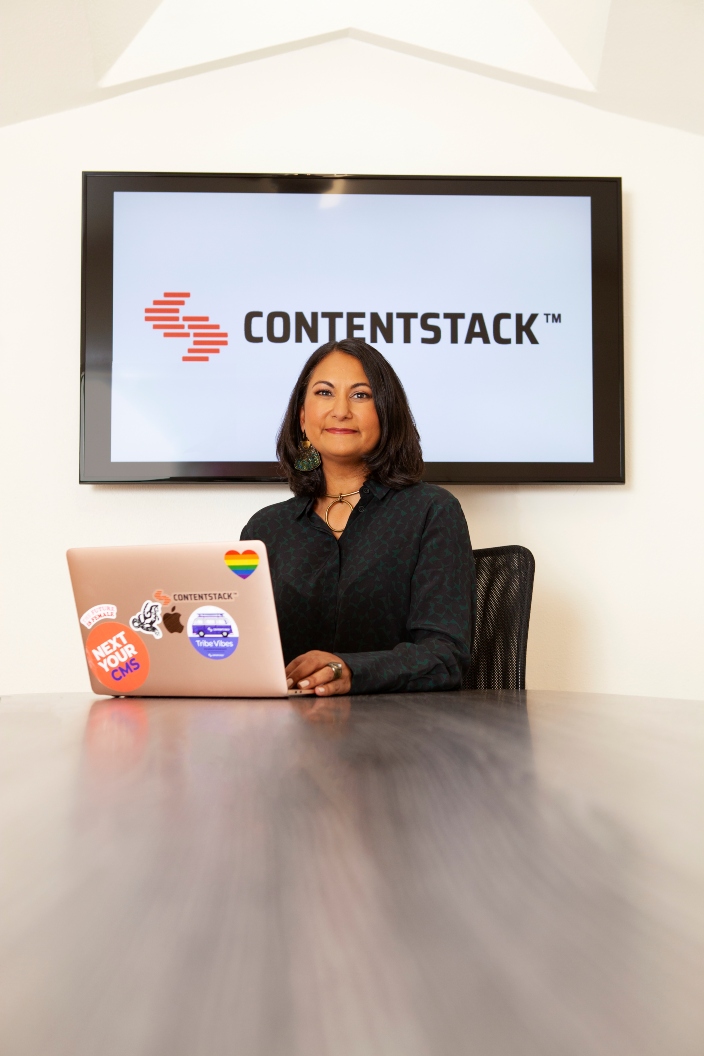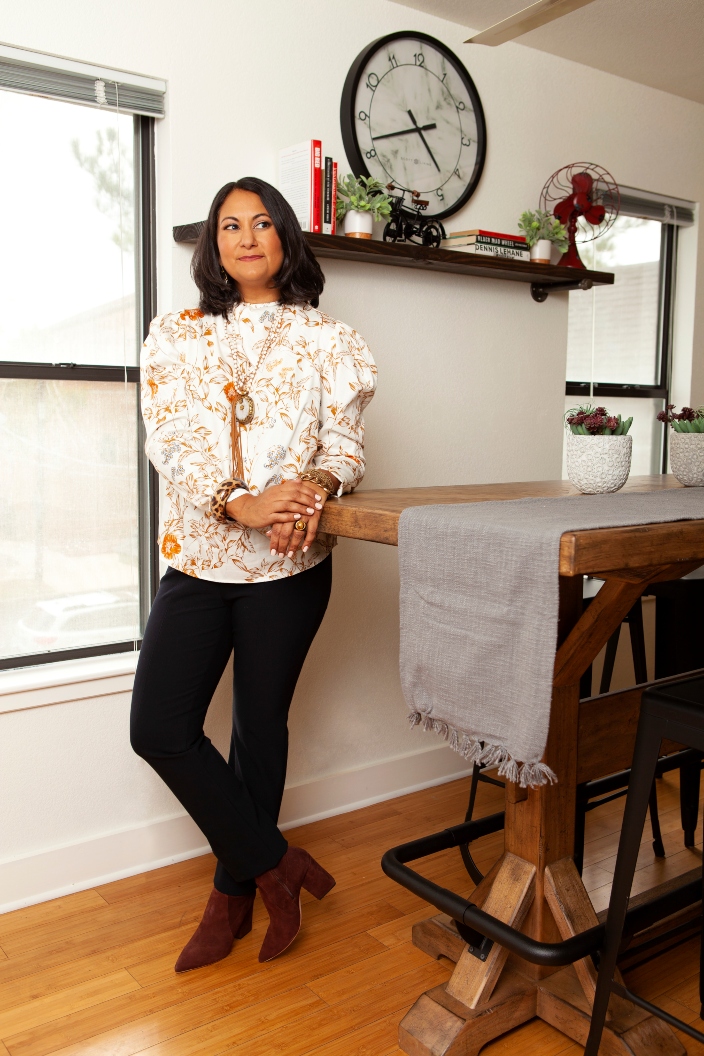Contentstack CEO Neha Sampat builds a business and a community.

By Jenny Hoff, Photos by Rudy Arocha, Styled by Parke Ballantine with inspiration from Hearth & Soul and Wood & Rose, Makeup by Alicia Beller, Shot on location at Contentstack
The year: 2019. The place: Valle de Guadalupe, Mexico. Neha Sampat treats her top sales people to a winery tour during her company’s annual Winner’s Circle event. The group enjoys the earthy varietals in this olive tree-filled region dubbed Mexico’s “Little Tuscany,” an area that produces 90% of Mexico’s wine. Sampat, a certified sommelier, shares her deep knowledge of the grape, its notes and the history of Mexico’s wine country.
It’s a hat trick she’s used at many investor and tech events. Giving insight to wine enthusiasts on the differences of each wine and the story of each producer. But at this specific event, her nerves are stretched. After 100 pitches during a Series A round of funding for her business Contentstack, she finally landed an investor that shares her vision for the company. But, the closing was taking weeks longer than it should. If the deal—and money—didn’t come through soon, Sampat would have to downsize her company and make some hard decisions.
“I had bet on the investment and had already grown the team,” recalls Sampat. “It’s a bit like gambling, except you’re betting on yourself.”
Sampat has been betting on herself since she was a little girl. Growing up in Pomona, California—the town her parents settled in after leaving India—Sampat watched her parents struggle financially as her father tried to make his various business ideas work. Sampat, motivated to earn her allowance from potential customers instead of Mom and Dad, decided to start her own business when she was about 11 years old. One that would meet the demands of her peers.
“Business is Simple”

“My friends and I created a New Kids on the Block fan club,” laughs Sampat. “I used my parents’ print shop to make fan books and mail them to my members. We made around $1,000 and used that money to invest in setting up a babysitter’s club.”
While $1,000 is peanuts compared to the valuation of the company she would build as an adult, her early success gave her the confidence to not only believe in her ideas, but to do something with them. While business experts use fancy terms and daunting spreadsheets to explain how to turn a profit, the essence of starting an enterprise is to earn more money with your product or service than the cost to deliver it.
“I’ll never forget what one of my professors said when I got my MBA,” says Sampat, as she stands up to imitate her former teacher. “Business is simple. It’s about increasing revenue and decreasing costs.”
Twenty years later, sitting on a tour bus with the top employees of Contentstack, Sampat thought about her balance sheet and the hundreds of employees, from India to San Francisco, who counted on her. Would she receive the infusion of funds she desperately needed to grow her business and keep her team?
“It was [at]that moment that my banker called and said the closing had happened. The money was in our account,” she says. “I was so relieved I burst into tears.”
Building Community
Four years earlier, Sampat was on another trip, this one in Mumbai, India. She remembers sitting down in a cramped dormitory-style living space. Perching in one of the 200-square-foot rooms that surrounded one small shared kitchen and a tiny bathroom. This is where her family lived before she was born. Each one of the rooms surrounding her had housed a whole family—some with four, five and six members.
Sampat started her video camera as she watched her dad, Kris Sampat, sipping his tea and looking around the space—his body present, his eyes in another time. As Sampat filmed, her dad recounted his life there: the noise, the activity, the community. The lack of space leading to deep friendships, friends who became family.
In 2015, as she filmed her father in that room, Contentstack was still fairly small. Sampat hadn’t hit any of the milestones of outside investors or hundreds of employees. Her company was made up of her, her husband, her best friend, a small team of workers who felt like friends and some engineers who were based in Mumbai, not far from where she currently sat. While her life in the U.S. was far from where her parents had started out, she found it easy to imagine their lives in that commune-like living situation and the bonds they created with the other families around them.

The Disruptors
When she and her husband, Nishant Patel, first started building a business together, it was in her apartment living room. The company was called Raw Engineering (which still exists), a service-based business helping companies develop better CMS strategies. Contentstack was born from Raw Engineering and delivers software products that provide that function, allowing developers and companies to better command all of their content platforms and more easily build specialized apps and websites.
The content management space is a $60 billion industry. Patel, who has an engineering background, and Sampat, who specialized in product marketing, were convinced they could disrupt it in a way that hadn’t been done in 30 years. To take that leap from a comfortable salary in a secure job to aiming to upend an industry takes a lot of patience, sacrifice and guts.
“But if you are that type of person, you can’t do anything else,” says Sampat. “You have to be willing to be beat down to the ground and then kicked and then also uplifted on the same day. Sometimes within the same hour.”
Sampat was willing. While her husband started growing Raw Engineering and traveling to India to build a team, Sampat kept her day job in product marketing at a Silicon Valley firm. She paid her first employees out of her own paycheck. In those early years, Sampat and Patel lived as lean as possible. Canceling subscriptions and budgeting only for their mortgage, groceries and utilities. They put everything else into the business. Helping it sputter along until it would start producing enough revenue on its own.
Hitting the Target
“I had this big piece of paper on the back of my bedroom door. It had a reminder of how much recurring revenue we had to get in order for me to quit my job,” she recalls. “I looked at it everyday before I left for my day job. Literally, the day we hit the target, I put in my notice.”
While Sampat’s business took off more than any enterprise her father had started, she attributes much of her leadership philosophy to him. He built community and treated his employees like his own family. During his print shop days, Sampat recalls going in on the weekends and helping with any task she could. She also recalls her father making a promise to the son of one of his employees. If he finished high school, Kris would buy him a truck.
The Ties That Bind
“I don’t know how he did it financially, but he did,” recalls Sampat. “My dad was one of those people who always gave back. Whatever little he had he would always give. That stuck with me too. This spirit of extending the ladder down and helping the others up.”

Six months after their trip to India together, Kris Sampat unexpectedly passed away from a heart attack while on a family trip, celebrating his 50th wedding anniversary. As the patriarch of the family, his death left a gaping hole in their community. Neha was devastated. But amidst all the grief and upheaval, there is one moment that she’ll never forget.
“At his funeral, the first row was filled with the other families who had lived with them in that small space in Mumbai,” she says with a tender smile. “They were the ones crying the hardest. The bond they had formed was still just as strong decades later.”
Building a Community
The motto at Contentstack is “The tribe vibe.” It’s a culture built on community, collaboration and cooperation. Even as it has grown to more than 330 employees, based around the world, Sampat works hard to keep the connection. So much so that she’s taken on an executive coach to make sure she doesn’t let her personal attachments affect her ability to make the best decisions for her business.
“She had to really learn how to appropriately set boundaries and address conflict,” says Corinne Mason, Ph.D., co-founder of Summit Leadership Partners and Sampat’s executive coach. “In many founder-led companies, you have prior relationships with people who you started the company with. Her best friend is the COO, her husband is the CTO. As you grow, you start to have things you need to debate around in regards to who owns decisions and who needs to make the final call. It’s a challenge for any CEO; it’s even more of a challenge for a woman CEO.”
The Tribe Vibe
Growing a business also sometimes means parting ways with team members. A hard decision that has proven to be one of the more difficult aspects of leadership for Sampat.
“Some individuals have a hard time letting go of the past and embracing the changes in the company,” says Patel. “As a leader who cares about all these individuals, I’ve seen her struggle to get each and every member [to]come along for the ride. She struggles with the goodbye.”
Sampat admits growing pains can be hard. She’s learning to get better at goodbyes if they’re in the best interest of the company. But she refuses to give up that family feeling, the “tribe vibe,” no matter how large the business grows. Most tech companies in Austin fill up the shiny high-rises downtown or populate the newer buildings near the Domain. For the second headquarters of Contentstack, Sampat chose a cozy historical home in East Austin. With a small yard and white facade, the house maintains its historic charm. Inside, murals of Austin adorn the walls, giving it a local, distinct atmosphere. A galley kitchen is stocked with coffee and a variety of milk options.
What once were bedrooms are now small offices, close enough that you can have a conversation with other team members without having to get up. When they opened the doors in January 2020, Sampat wanted to make sure it felt like home and even created a dog corner with treats and water bowls. Upstairs, she installed a wine bar, with a carefully curated collection that Sampat and her co-founder, best friend and fellow sommelier, Matthew Baier, personally chose.
When COVID-19 hit just weeks after they crossed the threshold, Contentstack’s new work home emptied out while Sampat’s personal house filled up.
The Family Balance

Being a founder and CEO of a tech company worth millions of dollars doesn’t preclude you from the responsibilities of family life. Just as Sampat’s company went 100% remote, she also became a first-time mom overnight.
“My sister-in-law’s husband is a pulmonary physician, and they had a new baby,” explains Sampat. “We decided that to keep [the baby]and our parents-in-law safe, my sister-in-law would stay at home with her husband and older children. The baby and my in-laws would move in with us to keep them safe.”
After years of trying to conceive on their own, failed IVF attempts and even starting the process for adoption, Sampat and Patel suddenly became parents to a four-month-old bouncing baby boy. For seven months the family of two turned into a family of five, with Patel’s parents and baby Arhaan in the house, huddled together inside.
Nurturing Growth
This new family configuration, while sudden, wasn’t all that new for Sampat. When she met Patel 20 years earlier, fresh out of college, his family moved from India to be with him almost immediately. The couple skipped the honeymoon period of first love and went headfirst into taking on the responsibilities of supporting his family, helping raise his younger sister and eventually putting her through college. Now, as serendipity would have it, they were helping raise her son so she could protect her family.
Sometimes the world works in mysterious ways. After two decades of marriage and the emotional toll that comes with trying to have a baby, Sampat and Patel are finally content with focusing on nurturing their company’s growth while helping out with the tiny humans in their family.
“It was fun and we love him. But we were both like, ‘This is cool; let’s just be an aunt and uncle,’” Sampat says with a laugh. “We still see him every day, we get the beautiful hugs. And when they need a break we can take all the kids for them. We are getting our fill.”
Learning to Lead
While Sampat was hunkered down in her home with a baby, her parents-in-law and husband, she also happened to be on another quest to raise money for Contentstack. After growing the company 150% since their first round (Series A), where she had to pitch 100 times to companies in New York and Silicon Valley before securing an investment of $31.5 million, Sampat was poised to grow her company even more with an even bigger valuation. This time, it was all virtual, and the investors came to her.
Of the thousands of businesses that venture capital firms invest in annually, only 2.3% of them are woman-led. Between the amount she raised in Series A and the $57.5 million she ended up raising in Series B, Sampat’s company was in the top 5% of the most money raised by a female-led enterprise company.
Investing in Women
Sampat is hopeful more investors are seeing the benefit of investing in women-owned businesses. And some are. True Wealth Ventures, based in Austin and run by two female veterans of the tech industry, commits to only investing in women-led businesses. Not just for personal reasons, but because it makes financial sense.
“Data show that women-led companies outperform financially,” says Kerry Rupp, general partner of True Wealth Ventures (along with her business partner, Sara Brand, the 2017 Austin Woman magazine cover woman). “There have been numerous studies on this topic over the past five to 10 years [that]show that women-led companies raised 45% less capital but generated 10% more revenue and 2.5 times higher returns.”
Contentstack is no exception. With the substantial investments, Sampat can now grow her team exponentially, putting their product into as many companies as possible. Her company already serves some of the largest Fortune 1000 brands. And the leadership team has their eyes on growing as big or bigger than their main competitor, Adobe.
Growth Means Change
Even though that growth may come with substantial change, Contentstack’s COO, Matthew Baier, has no doubt Sampat is the woman who can lead the charge.
“When you’re a super tiny company, everyone can dream big,” says Baier. “As you grow the key is to add to the magic, not to dilute the magic.”
Adding to the magic includes making strategic and thoughtful decisions—in business and philanthropy. While many corporations have blanket give-back programs as part of their overall portfolio, Sampat has a much more deliberate and personal approach with her company’s community impact.
Blackout Austin
Recently, she hosted a party called Blackout Austin at her own house to raise money in support of Partnerships for Children, an organization that supports foster children in the area. When COVID-19 ravaged India, she raised $75,000, which provided millions of meals to the community where her Indian team is based. She also immediately took action to protect her employees.
“Early on, she recognized the gravity of COVID and had everyone start working remotely,” says Renee Holland, the head of people at Contentstack, who leads their HR team. “The engineers in India were set up with internet at home with two backup internet sources as well. When the Delta variant hit India hard, she made sure her team there was taken care of. That they had hospital beds if they needed it, that we had oxygen if we needed it.”
Extend the Ladder

Sampat not only seeks out ways to encourage women and underrepresented minorities to join the tech space; she has her own company actively seek out employees who may not have obvious access to the industry. And it’s not about only doing right by those underprivileged. Her friends and colleagues say Sampat just does right by people, period.
“I work with a lot of executives,” says Mason. “She is one of the few who has turned around and asked how she can help me. And she does it. She bought a whole table at the [Woman’s Way Business] Awards and introduced me to other executives. That’s how she is.”
Sampat may be newer to Austin, but she exudes the old Austin vibe. Yes, it’s a cutting-edge city, a tech powerhouse and rapidly growing, but it’s also relaxed, inclusive and happy. Sampat may have spent much of her career in Silicon Valley. But her upbringing in a small California town in a house constantly filled with relatives and friends, with a spot always open at the dinner table, taught her early on that building community is more important than building a resume. As her father always reminded her, true success isn’t just personal achievement; it’s remembering to extend the ladder down and bring others up along the way.

Sip and Learn with Neha Sampat
As a certified sommelier with the Court of Sommeliers, what are three wine facts that can impress any guest?
The main trick to sabering a bottle of sparkling wine is to make sure it’s chilled on ice prior. The colder the bottle, the easier it is to saber. It’s a fun party trick if you do it safely.
If you plug your nose while sipping a wine, it completely changes the flavor of the wine. Have people try this in a wine tasting. It’s both silly and insightful!
You can liken the “body” of a wine (i.e. light-bodied, medium-bodied or heavy-bodied) to forms of milk (i.e. skim milk vs. whole milk).
Three tips for picking a good wine?
- If you like Chateauneuf-du-Pape, look for a Gigondas. You can often find a wine with similar taste and quality of a Chateauneuf-du-Pape at a fraction of the cost.
- Similarly, if you like Barolo and Barbaresco wines from Italy, look for a Langhe Nebbiolo. Langhe Nebbiolo often gets made by the same producers but costs much less.
- All rules aside, the most important thing is to drink what you like. Wine is a form of art, and all art is subjective.


